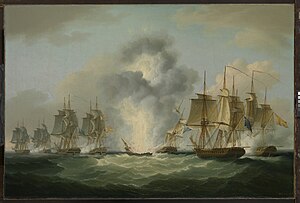Flotilla

A flotilla (from Spanish, meaning a small flota (fleet) of ships), or naval flotilla, is a formation of small warships that may be part of a larger fleet. A flotilla is usually composed of a homogeneous group of the same class of warship, such as frigates, destroyers, torpedo boats, submarines, gunboats, or minesweepers. Groups of larger warships are usually called squadrons, but similar units of non-capital ships may be called squadrons in some instances, and flotillas in others. Formations including more than one capital ship, e.g. men-of-war, battleships, and aircraft carriers, typically alongside smaller ships and support craft, are typically called fleets, each portion led by a capital ship being a squadron or task force (see reference below).
A flotilla is usually commanded by a rear admiral, a commodore or a captain, depending on the importance of the command (a vice admiral would normally command a squadron). A flotilla is often divided into two or more divisions, each of which might be commanded by the most senior commander, nearly always a lieutenant at the very least. A flotilla is often, but not necessarily, a permanent formation.
In modern navies, flotillas have tended to become administrative units containing several squadrons.[1] As warships have grown larger, the term squadron has gradually replaced the term flotilla for formations of destroyers, frigates and submarines in many navies.
A naval flotilla has no direct equivalent on land, but is, perhaps, the rough equivalent in tactical value of a brigade or regiment.
US Coast Guard
In the United States Coast Guard Auxiliary, a Flotilla is the basic organizational unit and consists of members at a local level where the majority of the work of the Auxiliary is done. A Flotilla is led by an elected Flotilla Commander assisted by an elected Vice Flotilla Commander, who is in turn assisted by appointed Flotilla Staff Officers.[2] A Coast Guard Auxiliary Division consists of multiple Flotillas and a District consists of multiple Divisions. Auxiliary Districts are organized along Coast Guard District lines and are administered by a Coast Guard officer (usually a Commander or Captain) who is called the Director of the Auxiliary.
Russian Navy
In the Russian Navy, the word flotilla has tended to be used for "brown-water" naval units – those operating not on the oceans and real seas, but on inland seas or rivers. Among the former are the present-day Caspian Flotilla, the early 20th century Satakundskaya Flotilla, or the Aral Flotilla of the 1850s;[3] among the latter, the Don Military Flotilla (which was created several times over more than 200 years), the Dnieper Flotilla (also extant in the 18th and 20th centuries), the Red Volga Flotilla, which participated in the Kazan Operation during the Russian Civil War, and the Danube Flotilla. In the 18th century, the term also applied to the comparatively small fleets operating on those seas where Russia did not have much naval presence yet, e.g. the Okhotsk Flotilla.
Non-military usage
The word flotilla has also been used at times to refer to a small fleet of vessels, commercial or otherwise.[4] There is also such thing as a flotilla holiday, in which is a group of chartered yachts that set sail together on the same route.
See also
- Tactical formation
- Task force
- Chesapeake Bay Flotilla of U.S. Navy (War of 1812)
- 10th Assault Vehicle Flotilla
References
- Chief Director of Auxiliary (2007-02-15). "USCG G-PCX Web Site – Flotilla Organizational Structure". USCG Auxiliary Office of the Chief Director (CG-3PCX). Archived from the original on 2007-09-28. Retrieved 2007-03-15.
- ^ "military unit." Encyclopædia Britannica. 2010. Encyclopædia Britannica Online. 16 Oct. 2010 <http://www.britannica.com/EBchecked/topic/1346160/military-unit>: "Administratively, several ships of the same type (e.g., destroyers) are organized into a squadron. Several squadrons in turn form a flotilla, several of which in turn form a fleet. For operations, however, many navies organize their vessels into task units (3–5 ships), task or battle groups (4–10 ships), task forces (2–5 task groups), and fleets (several task forces)."
- ^ As described at the Flotilla Organization Archived 2007-03-17 at the Wayback Machine page of the U.S. Coast Guard.
- ^ Ram Rahul. "March of Central Asia". Published 2000. Indus Publishing. ISBN 81-7387-109-4. p.160. On Google Books
- ^ "OCSC Sailing School". OCSC. Archived from the original on 11 June 2017. Retrieved 23 March 2018.
